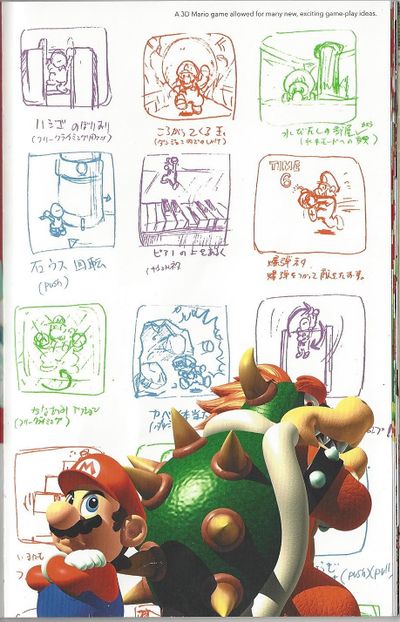If you appreciate the work done within the wiki, please consider supporting The Cutting Room Floor on Patreon. Thanks for all your support!
Prerelease:Super Mario 64 (Nintendo 64)/1994
Jump to navigation
Jump to search
This is a sub-page of Prerelease:Super Mario 64 (Nintendo 64).
Early Development
Development Process
Shigeru Miyamoto, contrary to popular belief, didn't conceive the idea of Super Mario 64 from seeing the capabilities of the Super FX Chip. The chip was codenamed "Super Mario FX", but a build was never developed for SNES hardware.
- According to Miyamoto, the Mario head on the title screen was taken from a "prototype for Mario Paint 3D", a game which was never released but may have become Mario Artist Paint Studio for the 64DD.
- The developers spent about half of their time working on the basic game system. Course design was done closer to the end, and many levels were almost "thrown together" (this may reflect the nature of level layouts like Whomp's Fortress, Lethal Lava Land, and possibly Tick Tock Clock (based on "tag.cnf" and "star" from the source code) as little changed of them between the Shoshinkai '95 build and the final game). Level design was less constrained thanks to the Nintendo 64's built-in Z-buffer, which allowed for complex geometry without having to pre-compute its draw order. Most of the design work was done directly on the computer hardware - only a few concept sketches and notes were made prior to jumping into the program. Level designers started with basic geography, then added more details as time went on.
- Yoshi was intended to be implemented for some part of the game, but the developers were dissatisfied and took out the feature. In order to not waste their work on Yoshi, they put him on top of the castle. Evidence of this exists in the leaked code which contains an older textureless Yoshi model dating to mid-1995. Contrary to popular belief, the unused egg that resembles one of Yoshi's is unrelated, and was in fact meant for Hoot.
- Luigi was removed in February 1996 due to memory issues. The team wanted to put him in a Mario Bros.-type minigame instead, but the fact that the Nintendo 64 was sold with only one controller factored into his total removal.[1][2]
- Initially, the developers worked on a "deceptively simple" test level: a basic room made of blocks similar to LEGO (likely, given Nintendo's history, N&B Blocks) where Mario and Luigi could test out basic 3D platforming and controls. It is unknown whether this relates to the unknown level seen in a later build.
- Originally, there were nearly 250 different animations for Mario, but roughly 55 were removed or rejected from the game prior to its release. Mario's animations were also originally intended to be entirely mocapped, but the developers took to animating by hand instead. Only 193 animation files are used in the final, with 242 animation files appearing in the leak, and an additional 5+ animations that were found by name or action, plus animations that only appeared in Spaceworld 95' Demo, adds up to around 250.
- The crouching trip kick (Z + B), present in the final game, was intended to be for attacking short/small enemies (presumably, the enemies from Tiny/Huge Island), but the developers never added any enemies that were specifically targeted by that move.
- Mario was originally able to throw MIPS the rabbit, but this was removed. Developers also wanted to create an animation where Mario throws him by the ears, but this was never added in time.
- There were once more monkeys in levels that could be chased around. A group of three would have taunted Mario, and he was able to throw them off of cliffs in turn. Remnants of this can be found in the final's Tall, Tall Mountain, where two Ukikis can be found.
(Source: shmupulations)
Concept Art
A few pages of development notes and concept art from various Mario games were published in the booklet that was included with the Wii release of Super Mario All-Stars in December 2010. While the developer notes were translated into English, this Super Mario 64 concept art page was not.
| Climbing/Dismounting Ladders | Rolling Stone | Flooded room |
|---|---|---|
| (Animation used in free climbing) | (A device used in dungeons) | (Camera switches to water mode) |
| Clockwise Millstone Rotation | Walking Over a Piano | Bombs |
| (Push) | (Sound stuff) | (Defeat enemies with bombs) |
| Wire Mesh Action | Wall Slam | |
| (Free climbing) | (Dash) |
(Translations: GlitterBerri)
- ↑ Shmuplations (2016, September 21). Super Mario 64 – 1996 Developer Interviews. "...until February, he was in the game. (laughs) Ultimately, due to memory issues, we had to take him out. Then we were going to include him in a Mario Bros. style minigame, but because most users probably only have that one controller when they first buy their N64, for that reason (and others) we decided not to."
- ↑ MacDonald, K. (2020, September 14). Super Mario at 35: Mario's makers on Nintendo's most enduring mascot. "When we tried running our experiments with 3D on a console, Mario was the only thing that moved. Of course there was no background, either. While we'd expected things to be limited, what we ended up with was even less than we anticipated. It was at that point that we gave up on having Mario and Luigi appear at the same time and decided instead to rework the gameplay."
